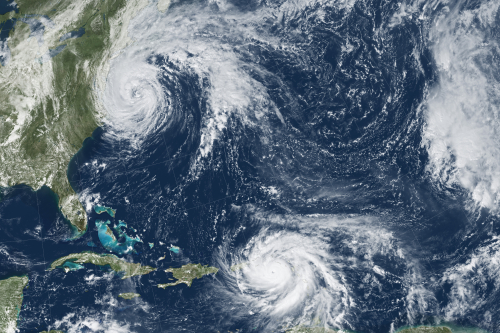The Climate group carries out a wide range of research centered around four major themes/ areas. The areas and the associated faculty members are:
- Anthropogenic Global Warming
- Polar Climate
- Changes in Extreme Weather
- Radiation and Climate
- Sustainability
Anthropogenic Global Warming
Faculty members: Ariya, Dufour, Gyakum, Huang, Tan, Tremblay, Zuend, Fajber
The emission of carbon dioxide, aerosols, and other anthropogenic changes to the atmosphere composition result in global warming or climate change. The observation and modelling of the anthropogenic global warming, including the associated regional changes, is a scientific challenge because of the long timescales involved (decades to centuries or longer) and the presence of natural climate variations. McGill's Atmospheric and Oceanic Sciences department has the most professors devoted to the physical science of climate change at the university.

Observed surface temperature change ( Photo credit: UN Intergovernmental Panel on Climate Change Fifth Assessment Report, https://www.ipcc.ch/site/assets/uploads/2018/02/FigSPM-01.jpg)
Polar Climate
Faculty members: Ariya, Dufour, Gyakum, Huang, Tan, Tremblay
Polar regions play a key role in regulating the climate system and can mitigate or augment global warming. For instance, polar and subpolar oceans have made large contributions to the absorption and storage of the heat and carbon dioxide added to the climate system over the past decades. These heat and carbon uptake have lead to a warming and acidification of the ocean. Strong contrasts exist between the Arctic and Antarctic regions though. An illustration of the intriguing differences between the two polar regions is the dramatic shrinking of sea ice in the Arctic compared to modest changes in sea ice in the Antarctic in recent decades. In the atmosphere, the polar regions have a distinctive warming pattern that is shaped by interactions with ocean, ice, and land surfaces. McGill researchers use numerical models to simulate the climate of polar regions and participate in field campaigns to the Arctic to measure sea ice and atmospheric gases.

Students from our Sea Ice Group: P. Bourgault, C. Brunette, A. Desmarais went on Expedition PS115/2 on the Polarstern icebreaker (September 4 - October 16, 2018) in the Arctic. Photo courtesy of Amelie Desmarais.
Changes in Extreme Weather
Faculty members: Gyakum, Huang, Fajber
Extreme weather events can have dramatic human impacts. Extreme events are often a combination of noteworthy thermodynamic and wind conditions. For example, hurricanes need a continuous supply of evaporation to drive their intense winds and freezing rain events, such as the devastating 1998 storm in Montreal, require a flow of warm and moist air above a cold surface. There can be competing changes in these thermodynamic and wind conditions, which results in uncertainty in future changes in extreme weather. This scientific uncertainty is addressed by researchers at McGill using a combination of observational analyses, theory, and modelling.

Hurricane Maria and Jose viewed from space on September 19, 2017 ( Photo Credit: NASA GOES, https://eoimages.gsfc.nasa.gov/images/imagerecords/90000/90998/atlantic_goe_2017262_lrg.jpg)
Radiation and Climate
Faculty members: Ariya, Huang, Tan, Zuend
The balance between solar radiation and thermal radiation shapes the Earth's climate. This balance is affected by atmospheric constituents, such as greenhouse gases and aerosols, which gives rise to climate change. We strive to improve our knowledge of the radiative forcing that drives climate change, as well as the feedback mechanisms including ocean and sea ice responses that collectively define the sensitivity of the climate system to external and internal forcing.

Photo: 4xCO2 forcing (W m-2). The value of the forcing strongly depends on other atmospheric variables than the forcing agent itself (concentration of CO2) and thus varies geographically. We developed a convenient diagnostic method for estimating the forcing values on a case-by-case basis [Zhang and Huang 2014].